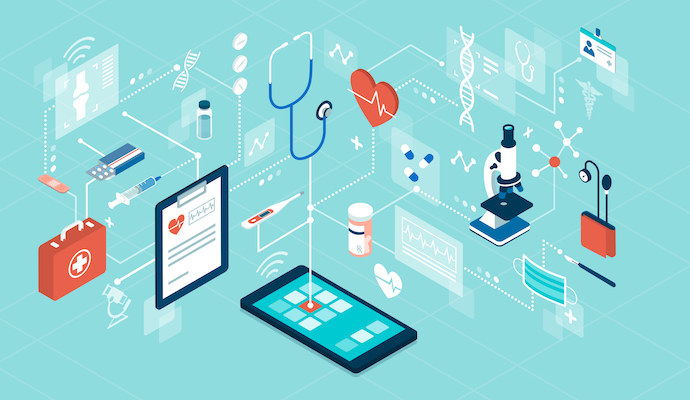3 Common Telehealth Technologies that Payers Cover, Leverage
Within the CDC’s three telehealth modalities, payers commonly turn to telehealth technologies including phone calls, secure direct messaging, and remote patient monitoring.

Source: Getty Images
- Phone calls, secure direct messaging, and remote patient monitoring are the three leading modalities that form the backbone of payer telehealth technologies.
According to the Centers for Disease Control and Prevention (CDC), there are three primary categories of telehealth: synchronous, asynchronous, and remote patient monitoring.
As telehealth technologies become more broadly used and available, members will have diverse preferences on what modalities work best for them. Payers can develop and cover technologies that fall under each modality in order to appeal to a broad range of member needs.
By leveraging these technologies knowledgeably and innovatively, payers can build more robust telehealth strategies.
Phone calls
Telephone calls or live audio-video connections between a patient and a provider are called synchronous telehealth modalities. The entire interaction takes place in real time through a mobile device or computer.
READ MORE: How Employers Are Accelerating Virtual Care, Telehealth Adoption
Providers may leverage this telehealth approach to check in on patients after a procedure. They can address non-urgent conditions by asking diagnostic questions to direct the patient to the appropriate form of care. Clinicians can also conduct some primary care services and preventive health screenings via phone call.
Phone calls can be useful mediums for mental and behavioral healthcare, enabling conversation between a professional and a patient remotely. Some payers have established hotlines and call centers to provide mental health support to members and the public.
For example, during the coronavirus pandemic, WellCare of New Jersey invested in a “warmline” for those who believe they might be at risk of a mental health crisis. A warmline is distinct from a hotline in that it is not for individuals who are in the midst of a mental health crisis but for those who may be progressing towards a crisis.
Individuals who were not a danger to themselves or to others could call in to receive guidance on how to connect with a therapist and receive mental or behavioral healthcare support.
During the coronavirus pandemic, payers also used call centers to help members discern whether they were exhibiting coronavirus-related symptoms and to distribute information about the virus.
READ MORE: Payers Can Use Telehealth to Increase Convenience for Members
Payers have faced some challenges in covering care delivered by audio-only telehealth, as opposed to virtual care services like video conferencing. Audio-only telehealth remains excluded from the Medicare Advantage risk adjustment model, much to the chagrin of organizations like Better Medicare Alliance.
Secure direct messaging
Secure direct messaging includes cell phone text messages, chat boxes, and portals that can send and receive messages, images, and other forms of data. These are considered asynchronous telehealth modalities. The technologies use a “store and forward” format to transfer information between the patient and provider.
Secure direct messaging can be used to deliver notifications to patients, answer patient questions, and transfer patient data. Patients can send pictures related to their condition through this telehealth platform.
Blue Cross Blue Shield of Arizona (BCBSAZ) used text messages to manage members’ challenges receiving and adhering to their prescribed medications.
Previous medication adherence programs relied on phone calls or letters to follow up with patients on their prescriptions.
READ MORE: Telehealth May Help Payers Control Uncertain Healthcare Spending
BCBSAZ targeted members with specific chronic diseases—cardiovascular and respiratory illnesses and diabetes. Once members signed up for the text messaging service, they received text alerts when they needed to refill their medications.
This approach enabled BCBSAZ to connect with members through the most accessible channel, increasing the chances that the member would actively respond to the message.
Remote patient monitoring
This modality can transfer information either synchronously or asynchronously. Remote patient monitoring technologies send a patient’s clinical data, such as her heart rate or glucose levels, to the provider.
“Maintaining continuity of care to the extent possible can avoid additional negative consequences from delayed preventive, chronic, or routine care,” explained the CDC.
“Remote access to healthcare services may increase participation for those who are medically or socially vulnerable or who do not have ready access to providers. Remote access can also help preserve the patient-provider relationship at times when an in-person visit is not practical or feasible.”
Remote patient monitoring can enable providers to track a patient’s health progress following a procedure. By receiving timely updates on the patient’s condition, providers can deflect potential crises before they fully develop.
These tools can also be instrumental in regulating chronic diseases. High quality, instantaneous data can provide better insights into how members’ daily routines affect their health conditions.
For example, UnitedHealth Group designed its new diabetes program, Level2, around a remote patient monitoring device. The company transformed the continuous glucose monitor—which is usually used for patients with type 1 diabetes—into a tool for those with type 2 diabetes.
The monitor delivered hundreds of readings per day. These readings go into the member’s individual health record. By looking at the readings over time, the payer can assess potential trends.
However, the remote patient monitoring device provides instantaneous information, meaning that the payer can also address health concerns the moment they occur even though the member is not in a provider’s office.
If a member had a sugar spike, the payer’s platform would let the member know certain steps he could take to control his sugar levels, through exercise or food consumption, for example.
As payers increasingly rely on telehealth, these three platforms may be fundamental to payer innovation.
